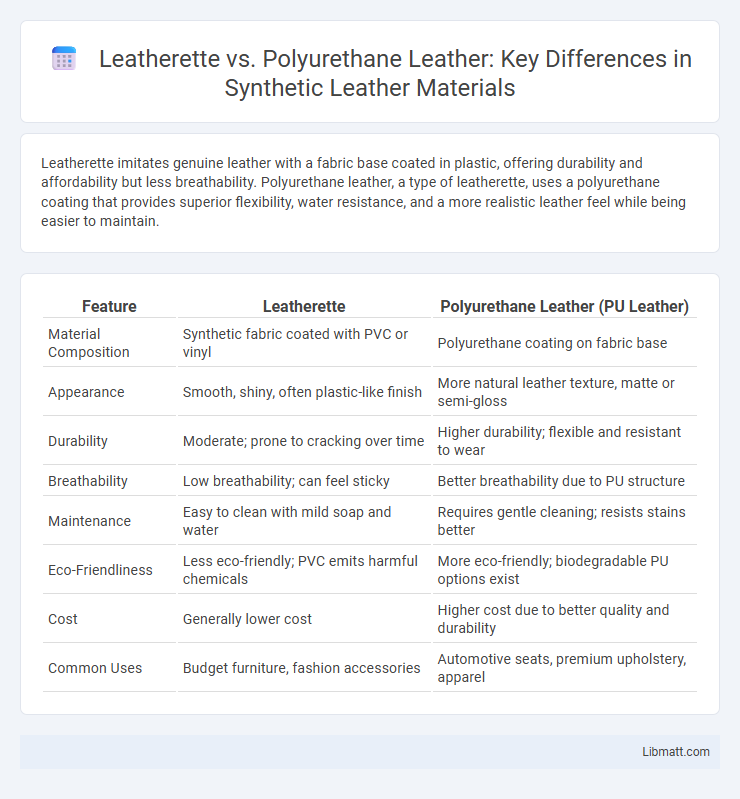Leatherette imitates genuine leather with a fabric base coated in plastic, offering durability and affordability but less breathability. Polyurethane leather, a type of leatherette, uses a polyurethane coating that provides superior flexibility, water resistance, and a more realistic leather feel while being easier to maintain.
Table of Comparison
| Feature | Leatherette | Polyurethane Leather (PU Leather) |
|---|---|---|
| Material Composition | Synthetic fabric coated with PVC or vinyl | Polyurethane coating on fabric base |
| Appearance | Smooth, shiny, often plastic-like finish | More natural leather texture, matte or semi-gloss |
| Durability | Moderate; prone to cracking over time | Higher durability; flexible and resistant to wear |
| Breathability | Low breathability; can feel sticky | Better breathability due to PU structure |
| Maintenance | Easy to clean with mild soap and water | Requires gentle cleaning; resists stains better |
| Eco-Friendliness | Less eco-friendly; PVC emits harmful chemicals | More eco-friendly; biodegradable PU options exist |
| Cost | Generally lower cost | Higher cost due to better quality and durability |
| Common Uses | Budget furniture, fashion accessories | Automotive seats, premium upholstery, apparel |
Introduction to Leatherette and Polyurethane Leather
Leatherette and polyurethane leather are popular synthetic alternatives to genuine leather, known for their durability and affordability. Leatherette, typically made from a fabric base coated with PVC, offers a textured, leather-like appearance while being water-resistant and easy to clean. Polyurethane leather, created by bonding a polyurethane coating to a fabric backing, provides greater flexibility, breathability, and a more natural leather feel compared to leatherette.
Defining Leatherette: Key Features and Composition
Leatherette is a synthetic material designed to mimic the look and feel of genuine leather, primarily composed of a fabric backing coated with a layer of plastic such as polyvinyl chloride (PVC) or polyurethane (PU). Its key features include durability, water resistance, and ease of maintenance, making it a popular choice for upholstery, fashion, and automotive applications. Understanding the composition of leatherette helps you appreciate its advantages over natural leather and informs your decision when seeking leather alternatives.
What Is Polyurethane Leather? Materials and Characteristics
Polyurethane leather, also known as PU leather, is a synthetic material made by coating a fabric base with a layer of polyurethane, creating a durable and flexible alternative to genuine leather. This material mimics the texture and appearance of real leather while offering water resistance, easy maintenance, and greater affordability. Your choice of PU leather ensures a cruelty-free option that combines aesthetics with practical durability for various applications like upholstery, fashion, and accessories.
Manufacturing Processes: Leatherette vs Polyurethane Leather
Leatherette is typically produced by coating a fabric base, often polyester, with a vinyl or PVC layer, resulting in a durable and cost-effective material. Polyurethane leather involves applying a layer of polyurethane to a textile backing, offering a softer texture and greater flexibility compared to traditional leatherette. Understanding these manufacturing processes helps you choose the material that best balances appearance, comfort, and durability for your needs.
Durability and Lifespan Comparison
Leatherette, typically made from PVC, offers strong resistance to water and stains but tends to crack and peel over time, resulting in a shorter lifespan of around 3 to 5 years with regular use. Polyurethane leather (PU leather) has a more flexible structure, providing better durability and resisting wear and tear more effectively, often lasting 5 to 7 years when maintained properly. Both materials are less durable than genuine leather; however, PU leather is generally preferred for applications requiring longer lifespan and increased flexibility.
Environmental Impact and Sustainability
Leatherette, often made from polyvinyl chloride (PVC), has a significant environmental footprint due to its production process involving harmful chemicals and limited biodegradability. Polyurethane leather, while synthetic, is considered more sustainable because it uses fewer toxic chemicals and offers better recyclability, reducing long-term environmental harm. Both materials lack the biodegradability of genuine leather, but polyurethane leather's eco-friendly manufacturing techniques position it as a preferable option for sustainable fashion and upholstery.
Comfort and Breathability Differences
Leatherette offers moderate comfort and breathability due to its synthetic fabric backing, making it suitable for short-term use but often less breathable than natural materials. Polyurethane leather typically features a thin polyurethane coating on a fabric base, resulting in improved softness and flexibility, which enhances comfort but still limits airflow compared to genuine leather. Both materials can retain heat and moisture, but polyurethane leather tends to provide slightly better breathability due to advancements in coating technology.
Maintenance and Cleaning Requirements
Leatherette requires minimal maintenance with simple wiping using a damp cloth and mild soap to remove dirt or spills, making it highly convenient for regular cleaning. Polyurethane leather demands more careful upkeep, including the use of specialized leather cleaners and conditioners to prevent cracking and maintain its texture over time. You can extend the lifespan of both materials by avoiding abrasive cleaners and excessive moisture, but leatherette generally offers easier and quicker maintenance.
Cost Analysis: Affordability and Value
Leatherette generally offers a more affordable option compared to polyurethane leather, making it a popular choice for budget-conscious consumers seeking cost-effective alternatives to genuine leather. While polyurethane leather tends to be slightly more expensive due to its enhanced durability and closer resemblance to real leather, it provides better long-term value through increased resistance to wear and tear. Your decision between the two should weigh initial cost savings against potential benefits in longevity and maintenance expenses.
Ideal Applications: Choosing the Right Material
Leatherette suits upholstery and fashion items demanding durability and affordability, often used in furniture and car interiors. Polyurethane leather offers enhanced flexibility and water resistance, making it ideal for clothing, accessories, and high-contact items. Your choice depends on application needs like wear resistance, appearance, and ease of maintenance.
Leatherette vs polyurethane leather Infographic

 libmatt.com
libmatt.com